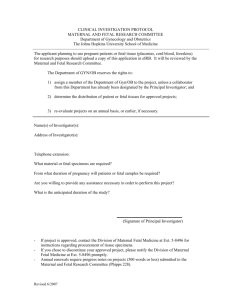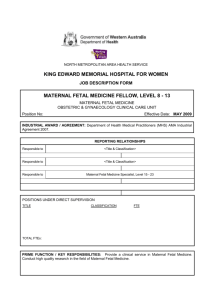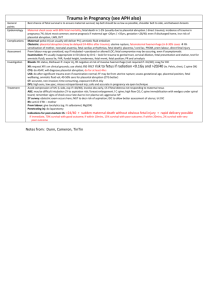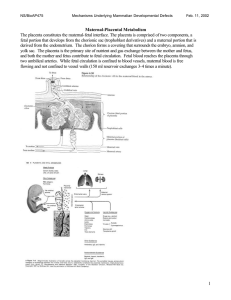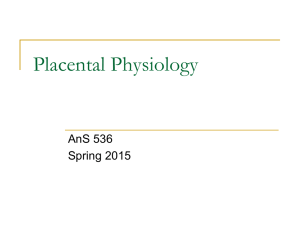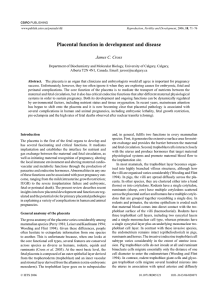Document 13626026
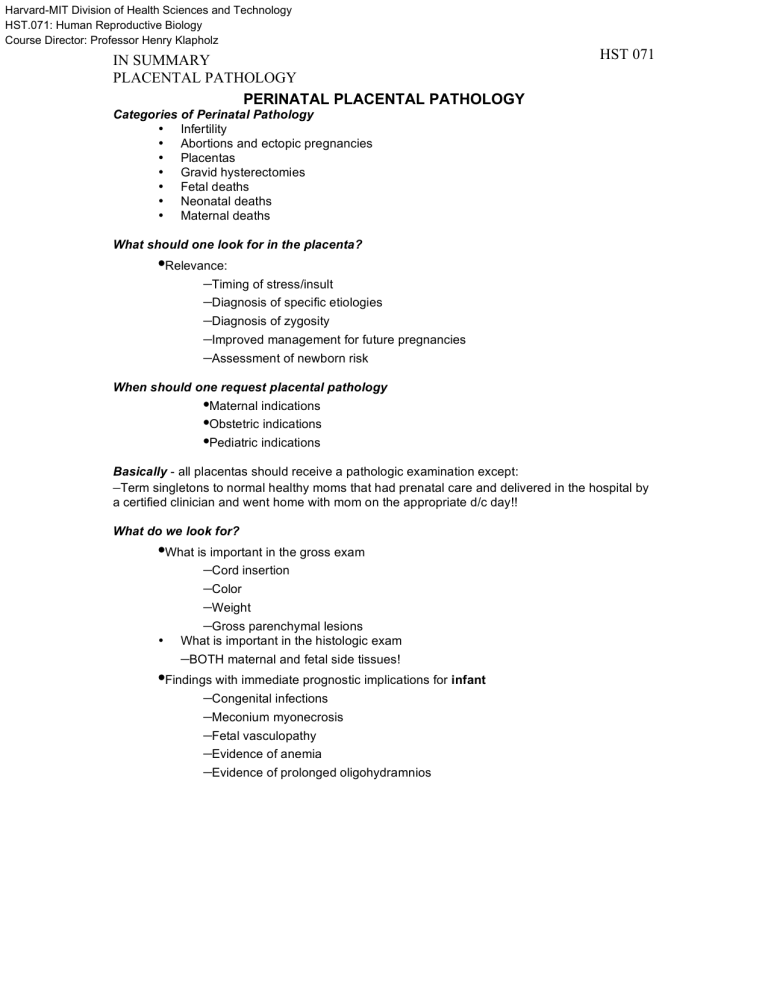
Harvard-MIT Division of Health Sciences and Technology
HST.071: Human Reproductive Biology
Course Director: Professor Henry Klapholz
IN SUMMARY
PLACENTAL PATHOLOGY
PERINATAL PLACENTAL PATHOLOGY
Categories of Perinatal Pathology
• Infertility
• Abortions and ectopic pregnancies
• Placentas
• Gravid hysterectomies
• Fetal deaths
• Neonatal deaths
• Maternal deaths
What should one look for in the placenta?
•
Relevance:
– Timing of stress/insult
– Diagnosis of specific etiologies
– Diagnosis of zygosity
– Improved management for future pregnancies
– Assessment of newborn risk
HST 07 1
When should one request placental pathology
• Maternal indications
• Obstetric indications
• Pediatric indications
Basically - all placentas should receive a pathologic examination except:
– Term singletons to normal healthy moms that had prenatal care and delivered in the hospital by a certified clinician and went home with mom on the appropriate d/c day!!
What do we look for?
• What is important in the gross exam
– Cord insertion
– Color
– Weight
– Gross parenchymal lesions
• What is important in the histologic exam
– BOTH maternal and fetal side tissues!
• Findings with immediate prognostic implications for infant
– Congenital infections
– Meconium myonecrosis
– Fetal vasculopathy
– Evidence of anemia
– Evidence of prolonged oligohydramnios
IN SUMMARY
PLACENTAL PATHOLOGY
Congenital Infections
• Acute chorioamnionitis most common
– Cervicovaginal flora
– Preterm rupture of membranes
• Transplacental infections rarer
– Viral
Fetal response
• Fetal response to acute chorioamnionitis includes: o Inflammatory cells migrating from fetal vessels
• Umbilical cord
• Chorionic plate
• “Vasculitis” is a risk factor for neurodevelopmental delay/cerebral palsy
HST 07 1
Transplacental Infections
• Maternal sepsis
•
Maternal viremia
•
Histology:
– Chronic villitis
Chronic Villitis
• Most are non-infectious (Villitis of unclear etiology - VUE)
– ~Host v. Graft
– ~1/3 recur and if recur associated with ~2/3 risk of IUFD or IUGR
• Infectious causes:
– CMV
– HSV
– Toxoplasmosis
Congenital CMV
• Fairly common infection
• Occurs in primary or recurrent infection in Mom
• Rarely causes fetal/infant problems
– IUFD
– IUGR
– Congenital deafness
– Poor neurodevelompent
CMV Placentitis
• Chronic villitis
• Stromal expansion of villi
• Inclusions
• Hemosiderin
IN SUMMARY
PLACENTAL PATHOLOGY
Congenital Listeria Infection
•
Maternal ingestion of contaminated foods
•
Mild maternal disease
•
Often lethal fetal disease
• Treatable for mom and infant/fetus
• ACUTE villitis and acute chorioamnionitis
– Macro and micro abscesses
Meconium
• Common after 40 weeks NOT a sign of fetal distress
• Before 40 weeks can implicate fetal distress
• Histologic findings can be correlated with length of time of exposure
• Problems arise with:
– Aspiration
– Prolonged exposure - myonecrosis
Timing meconium exposure
• Takes AT MINIMUM 1 hour to see meconium grossly or in the amnion
• Takes AT MINIMUM 3 hours to see pigment in chorion
• Takes AT MINIMUM 6 hours to see ulceration of amnion
• Takes AT MINIMUM 12 hours to see in Wharton’s jelly of umbilical cord
• Takes AT MINIMUM 18 hours to see myonecrosis
Meconium myonecrosis
• Post-dates
• Low Apgar scores
• Severe neurodevelopmental delay
Fetal Vasculopathy
• Thrombosis in fetal vessels of placenta
• Visceral infarcts
• Differential diagnosis:
– Heart failure
– Anatomic disorder of placenta
– Sepsis
– Vascular damage due to fetal inflammation
– Maternal diabetes
– Herited hypercoaguable state
– Meconium myonecrosis
RARE but WOW
• Metastatic malignancies
• Inborn errors of metabolism
HST 07 1
IN SUMMARY
PLACENTAL PATHOLOGY
HST 07 1
Placental findings with prognostic implications for mother
•
Villitis of unclear etiology
• Massive chronic intervillositis
• Malignancies
• Maternal floor infarct
• Decidual vasculopathy
Maternal floor infarct
• Rare disorder associated with:
– IUGR (24-100%)
– IUFD (13-50%)
– Cerebral palsy
– Recurrence (12-78%)
– Elevated MSAFP
• Diagnosis depends on gross and histologic exam
– “orange rind” like maternal floor
– Basal villi of entire maternal floor encased by perivillous fibrinoid of > 3mm thick
FUNDAMENTAL QUESTIONS
1.
What are the indications for placental pathologic examination?
2.
What gross features are commonly looked for in a placental examination?
3.
What is meconium? Why does it occur? What can the placenta tell us about meconium?
4.
What are some infections that can affect the fetus and placenta in utero?
5.
What is villitis? Chorioamnionitis?
IN SUMMARY
PLACENTAL PATHOLOGY
HST 07 1




